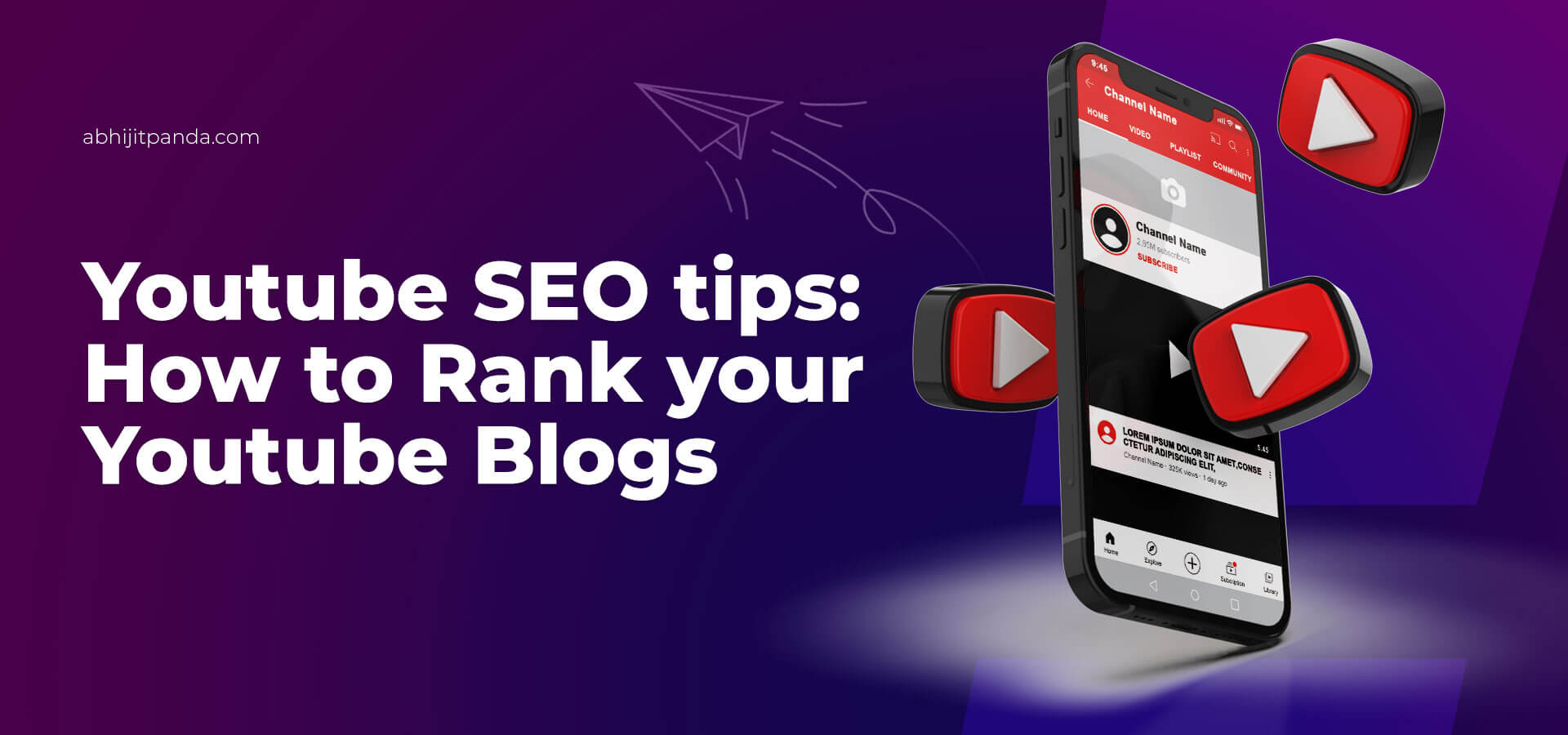 YouTube Video SEO Tips: How to Rank Your YouTube Blogs?
YouTube Video SEO Tips: How to Rank Your YouTube Blogs?
While finding information and conducting pre-purchase research, most searchers these days prefer watching video content to reading written content.
According to the noteworthy video consumption statistics posted on TechJury.net,
“Video is the number 1 source of information for 66% of people. People spend an average of 6 hours and 48 minutes per week watching online videos.”
That is why; many bloggers make their written content more appealing and engaging by embedding videos. At the same time, many bloggers these days write blogs and create video blogs (vlogs) on the same topics to cater to the varying preferences of searchers. As the most popular video-sharing platform, YouTube makes it easier for you to share a variety of video content and vlogs with the target audience.
But according to Statista.com,
“More than 500 hours of video were uploaded to YouTube every minute. This equates to approximately 30,000 hours of newly uploaded content per hour.”
You cannot get more views, likes, and shares without improving the visibility and rank of your YouTube blogs without implementing a slew of search engine optimization (SEO) techniques. In addition to crafting and publishing compelling video content, you must optimize the vlogs by adopting many YouTube video SEO tips.
13 YouTube SEO Tips and Best Practices to Get More Views, Likes, and Shares
1) Find Relevant Video Keywords
Like conventional SEO, YouTube video SEO starts with keyword research. Before optimizing your video blog, you must know what keywords or phrases searchers use to find similar video content. You can easily find and search list relevant video keywords using YouTube’s Search Suggest feature. You can make a list of keywords using this feature simply by typing the appropriate word or phrase on the YouTube search bar. Also, you get keyword ideas by reviewing the title, description, and video tags of some of the top-ranking videos on YouTube.
2) Finalize Video Keywords
While comparing the video keywords, you have the option to target low-competition and high-competition keywords. You can differentiate low-competition keywords from high-competition keywords based on the number of “about videos” displayed on Google search results pages. If your YouTube channel does not have a large subscriber base, it is always advisable to target low-competition keywords.
On the other hand, you can target high-competition keywords if your YouTube channel is popular and has a large subscriber base. However, it is always important to analyze the search volume for each of these keywords while finalizing the video keywords. You can easily reduce the time and effort required to find the right video keywords using a slew of keyword research tools for YouTube.
3) Focus on Increasing the Audience Retention Rate
As highlighted by many bloggers and digital marketers, the audience retention rate or viewer retention rate directly impacts a video’s ranking and visibility on YouTube. You cannot increase the audience retention rate without keeping a viewer engaged and persuading her to watch the video for a longer duration.
Your YouTube video SEO strategy must focus on retaining viewers by conveying the nature and intent of the video clearly in the first 10 to 15 seconds. Likewise, you can provide an overview of the video by allowing the viewer to preview it. It is also important to prevent the viewer from abandoning longer videos by showing impactful sneak previews.
4) Don’t Reduce the Video Length
Many bloggers and vloggers believe that they can easily increase audience retention rates by creating short video clips. But several studies suggest that longer videos rank higher than shorter videos on YouTube.
According to a study conducted by Pew Research Center,
“The YouTube recommendation system encourages users to watch progressively longer and more popular content.”
That is why; you must focus on creating longer videos instead of shorter videos. It is always important to increase the video length beyond 10 minutes by sharing relevant instructions and ideas with viewers.
5) Edit and Rename the Video File Name
The algorithms used by YouTube checks if your video to relevant to the targeted keyword based on the video file name. Hence, you can easily improve your video blog’s visibility on YouTube by including the primary keyword in the video file name. Before uploading the video, you must edit the file name to include the targeted keyword. However, it is also important to keep the file name descriptive to convey the nature and intent of the video clearly to YouTube.
6) Include the Exact Keyword in the Title Naturally
Most viewers will decide about watching your video only after reading its title. You can increase views only by keeping the video title clear, concise, and compelling. At the same time, you can boost the video’s visibility on YouTube only by including the primary keyword exactly. Several studies suggest that videos with exact keyword matches rank higher on YouTube. However, you need to ensure that the primary keyword is included in the title naturally while keeping the title concise.
7) Finetune the Video Description
Like search engines, YouTube understands a video’s nature and context based on its description. You can boost your video blog’s ranking and visibility on YouTube only by including the primary and secondary keywords strategically in the description. It is always important to compose a video description with more than 250 words. Also, you need to include the primary keyword in the 25 characters and ensure that it is repeated multiple times naturally.
8) Add Relevant and Popular Video Tags to the Video
Like description, video tags help YouTube algorithms to understand your vlog’s topic and context. Along with boosting your video’s ranking, video tags make the video appear on the sidebar area frequently. The video tags or YouTube tags can be both words and phrases. You must use the primary keyword exactly as a video tag, along with creating tags with variations of the keyword. Also, you can add relevant tags to your YouTube video by getting ideas from similar videos that rank higher for the same keyword.
9) Choose the Appropriate Category for Your Video
YouTube makes it easier for viewers to find relevant videos by dividing the videos and channels into multiple video content categories. You can categorize your video clips while uploading using the options included in the advanced setting. But you can enhance your video’s ranking and exposure only by linking it to the most appropriate category. It is always important to choose a video content category that matches your video’s context perfectly.
10) Add a Custom Thumbnail Image
While browsing YouTube, searchers refer to thumbnails to get a quick snapshot of the videos. The thumbnails make a searcher click or abandon a specific video clip by acting just like the cover of a book. After uploading a video, YouTube allows you to add custom thumbnails to the video by uploading your own file. Also, you can create a compelling and customized thumbnail for the video using a slew of online tools. But you must perform A/B testing to finalize a thumbnail that makes your video stand out from the crowd.
11) Add Subtitles and Closed Captions
You cannot increase your video’s popularity without making it accessible to viewers who do not speak your native language or cannot hear the audio. YouTube enables video bloggers to make their video content accessible to a larger audience by adding subtitles and closed captions. While uploading your video blogs to YouTube, you can add subtitles or captions by choosing from multiple language file formats. These features help you to boost your video’s YouTube ranking by increasing views and likes regularly.
12) Encourage Viewers to Interact with the Video
The study conducted by Pew Research Center suggests that popular videos rank higher on YouTube. YouTube measures the popularity of a video based on likes, shares, comments, and the number of subscribers. You can increase the popularity of a vlog on YouTube only when the viewers interact with your videos.
While creating the videos, you must request viewers to like and share the video as well as subscribe to your YouTube channels. Likewise, you must request viewers to share feedback and answer your questions by posting comments. However, it is always important to respond to the viewers’ comments and messages proactively.
13) Promote the Videos through Other Marketing Channels
You can leverage other marketing channels to divert more audience to the video blog as well as increase audience interaction. In addition to implementing YouTube video SEO tips and best practices, you must promote and popularize the video using social networks.
Also, you should consider embedding the video in your blog or posting it on your company website. Likewise, you can get more views and likes by using the video in your email marketing and digital marketing campaigns. The multiple marketing channels will help you to get more subscribers to your YouTube Channel.
While looking for YouTube video SEO tips, you must remember that the video-sharing platform changes and updates its algorithms regularly. You can keep your vlogs searchable and discoverable only by reviewing and finetuning your YouTube video SEO strategy regularly. It is also important to make the video SEO strategies more impactful by adopting new YouTube SEO tips and best practices regularly.









Leave a Reply